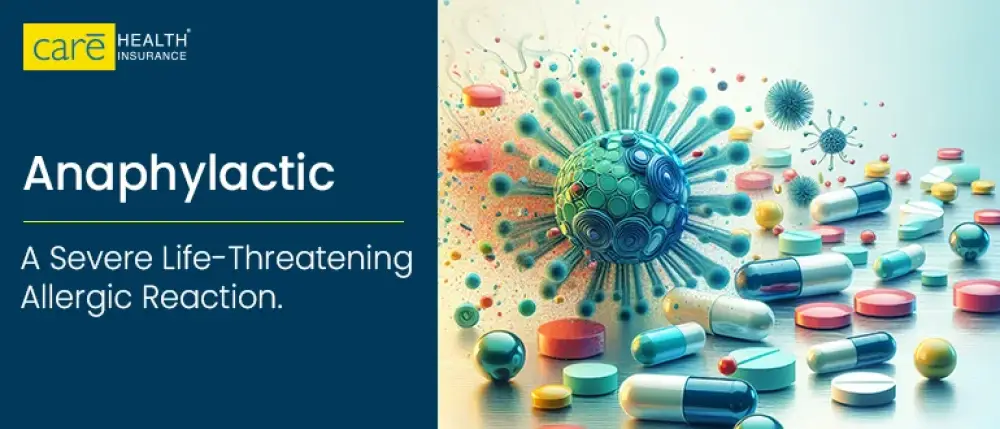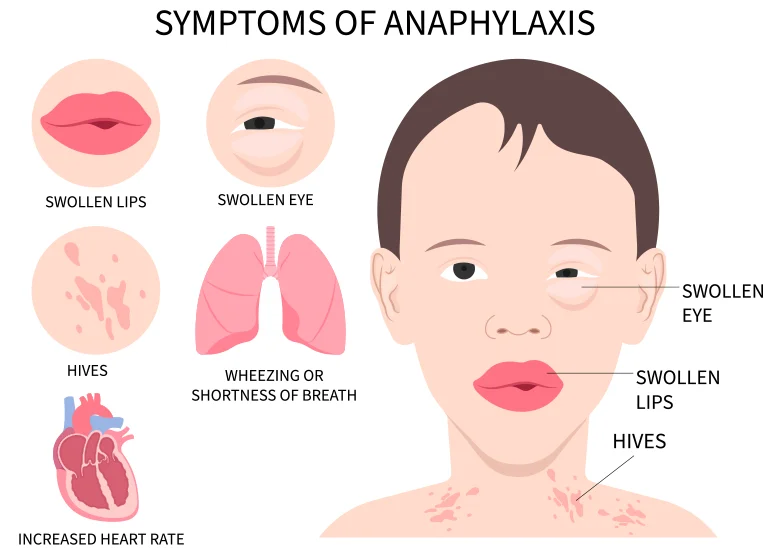Subscribe to get weekly insights
Always stay up to date with our newest articles sent direct to your inbox
Published on 6 Aug, 2025
Updated on 2 Sep, 2025
312 Views
4 min Read

Written by Sejal Singhania
Reviewed by Munmi Sharma
favorite2Likes
Imagine enjoying your favourite meal at a restaurant and strolling through a garden on a sunny day, when suddenly something feels off. Your skin itches, your throat tightens, and breathing becomes difficult. This could be a life-threatening allergic reaction known as anaphylaxis.
This medical emergency can develop within minutes and requires urgent action. Knowing how to respond and understanding when to call emergency services can help you effectively manage the situation. Let's explore the anaphylactic reaction symptoms and how to be prepared when it matters most.
Anaphylaxis is a serious, life-threatening allergic reaction that can happen quickly after exposure to an allergen. It occurs when the immune system releases a rush of chemicals, leading to a range of symptoms that can affect various parts of the body, such as the respiratory and cardiovascular systems. If not treated promptly, anaphylaxis can result in shock and, in the worst cases, even death.
When you have an Anaphylaxis allergy, your immune system reacts strongly by producing chemicals such as histamine. Signs of anaphylaxis include swelling, wheezing, trouble breathing, and difficulty swallowing. An anaphylactic reaction can impact multiple parts of your body simultaneously.
Anaphylaxis and its symptoms typically occur in stages. However, they can escalate quickly. Initially, your symptoms may be mild, but they can worsen over time. By identifying a reaction early, you can seek assistance before your symptoms become more serious or life-threatening. Certain healthcare providers divide the stages of anaphylaxis into four groups:
This phase can resemble a mild allergic reaction, which can make it difficult to recognise its severity. Symptoms may involve itching, redness, and swelling. Additionally, there could be a runny nose and sneezing. You might also feel a general sense of discomfort or that something is off.
Symptoms worsen and impact various body systems. This phase needs immediate medical care for increased rash, facial swelling, trouble breathing, wheezing, tightness in the throat, abdominal pain, nausea, vomiting, diarrhoea, rapid heartbeat, dizziness, and lightheadedness.
If not treated promptly, anaphylactic reactions can worsen, potentially leading to shock and organ failure. This can lead to decreased blood flow to organs, weakness or fainting, difficulty breathing, and the heart stopping.
This phase includes the reappearance of anaphylactic reaction symptoms following a short period of improvement. Although these symptoms are typically less severe than the first reaction, they can still range from moderate to severe and may need medical care.
An individual experiencing an anaphylactic reaction can spike anaphylactic shock if their blood pressure falls to a critical level. The bronchial tissues, responsible for air passage, may start to swell, leading to wheezing, difficulty breathing, and potentially loss of consciousness. At that time, immediate medical attention is essential to save the person's life.
An anaphylactic reaction can happen quickly, within seconds or minutes after exposure. Here are some anaphylactic reaction signs that you should watch for:
Some severe signs and symptoms of Anaphylaxis include:

Anaphylaxis is a severe allergic reaction where an antibody overreacts to a harmless substance (food, medicine, etc.). Initial exposure may not cause a reaction, but subsequent exposures can worsen it. Some of the major causes of anaphylaxis are:
Found in items such as disposable gloves, catheters and adhesive tapes.
If you've experienced anaphylaxis before, your risk is higher. Each time you react, it may become more severe. Other factors that can raise your risk include:
Pro Tip: Anaphylaxis emergencies usually need quick hospitalisation, ICU treatment, and medications, which can be expensive. But with the right Mediclaim Coverage Plans, you can receive the necessary care without stressing over the costs. So, don’t wait for a medical crisis to understand its importance. Be sure to get your safety net today.
If you suspect that you or someone nearby is experiencing an anaphylactic reaction, follow these steps:
Yes, although you cannot control how your body reacts, you can reduce the risk. Here are some anaphylaxis prevention tips:
>> Also Read: Signs To Know If You Have An Allergy?
Even if you take precautions, you will probably encounter your allergens at some time. Anaphylactic reactions can be frightening, quick, and hazardous, but with proper knowledge and resources, they can be handled. The important thing is to respond quickly, recognise the symptoms, and always be ready.
Disclaimer: The above information is for reference purposes only. Kindly consult your general physician for verified medical advice. Health insurance benefits are subject to policy terms and conditions. See policy documents for details.
Thyroid : मामूली नहीं हैं महिलाओं में थायराइड होना, जानें इसके लक्षण और घरेलू उपचार Vipul Tiwary in Diseases
शुगर कंट्रोल कैसे करे? जानें, डायबिटीज में क्या खाना चाहिए Vipul Tiwary in Health & Wellness
हाई ब्लड प्रेशर को तुरंत कंट्रोल कैसे करें? देखें इसके उपाय Vipul Tiwary in Diseases
पैरों में दर्द किस कमी से होता है? जानें, इसके घरेलू इलाज Vipul Tiwary in Health Insurance Articles
Cold Hands? Act Immediately Against Raynaud’s Phenomenon Jagriti Chakraborty in Diseases
Understanding Azotemia: Meaning, Causes, Treatment & ICD 10 Guide Leena Khowal in Diseases
Leukaemia vs. Lymphoma Breakdown: What Sets Them Apart Leena Khowal in Diseases
When Silent Clots Threaten Your Life: DVT Pratham Gupta in Diseases
An allergic reaction and anaphylaxis are both reactions to allergens, but anaphylaxis is a serious, life-threatening type of allergic reaction. While most allergic reactions are mild to moderate, anaphylaxis affects several organ systems and can lead to severe breathing and circulation issues.
Anaphylactic shock needs urgent medical attention, mainly through an epinephrine (adrenaline) injection. This should be followed by additional supportive treatments such as oxygen, antihistamines, and possibly corticosteroids.
Allergies that lead to anaphylaxis are lifelong. You can often control anaphylactic reactions by quickly using epinephrine. However, if you've experienced a serious allergic reaction, you should expect to have that allergy permanently.
Anaphylaxis reactions usually happen rapidly, often within minutes after coming into contact with an allergen. Some reactions can take place in 5 to 30 minutes, while others might take longer, even up to an hour or more.
Children can experience severe, life-threatening anaphylaxis, often triggered by food allergies like peanuts, milk, and eggs.
Always stay up to date with our newest articles sent direct to your inbox
Loading...